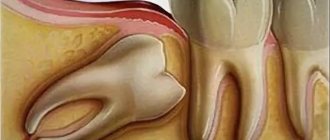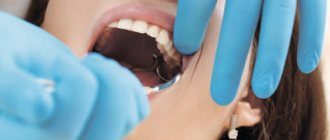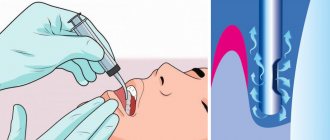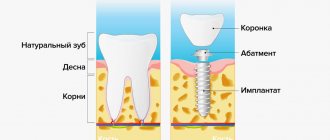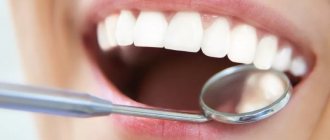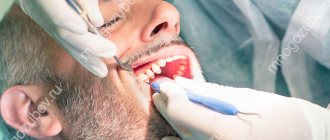Going to the dentist is always stressful for the patient. The main problem and fear before removal is pain. Modern technologies allow for painless removal, but this does not relieve patients from worrying about this problem. The wisdom tooth is rightfully considered one of the most difficult to remove, and therefore its painless removal is a real breakthrough in the field of dentistry. Specialists at the Zuub clinic perform wisdom tooth removal quickly, competently and without any pain.
Why complications often occur after wisdom tooth removal -
It must be said that the severity of negative symptoms after wisdom tooth removal directly depends on the degree of traumatic removal. In turn, the incidence of trauma depends not only on the simple or complex position of the tooth in the jaw, but, first of all, on the qualifications of the dental surgeon.
For example, surgeons often spend 1-2 hours trying to remove a patient’s wisdom tooth with just forceps and an elevator - instead of immediately making an incision in the gum, drilling out some bone around the tooth and/or sawing the tooth crown into several parts (after that, removing each root by separately), and spending only 15-20 minutes on it.
Another main cause of complications after complex wisdom tooth removal is the use of a drill by the surgeon, the surgical tip of which is not water-cooled. As a result, a thermal burn of the bone occurs, followed by severe pain and the development of suppuration in the socket of the extracted tooth.
Important: thus, the main causes of inflammation and other complications are the mistakes and negligence of the dental surgeon during the removal process.
However, a lot also depends on the doctor’s prescriptions. Correct prescriptions dramatically reduce the risk of developing inflammation of the socket.
What to do before deleting the eight
There are a number of rules to make surgery safer and reduce the risk of postoperative complications. Among them:
- Eat one to three hours before visiting the dentist (but if general anesthesia is planned, you cannot eat!). A preliminary meal before extraction, performed under local anesthesia, promotes better blood clotting and improves the patient’s physical condition.
- Carry out removal in the first half of the day (preferably in the morning). In the morning hours, the human body copes better with stressful situations. In addition, if the procedure is scheduled for the evening, the patient may experience insomnia due to persistent pain and nervous tension.
- Do not drink alcoholic beverages on the eve of surgery. They negatively affect the rheological properties of blood, which means that the risk of swelling and bleeding will increase.
- In case of severe anxiety, take a sedative of herbal origin. It is important that the person is not allergic to the drug used.
To remove the figure eight, you need to choose a clinic and a dental surgeon whose reputation is beyond doubt. Then the patient will be able to relax better, which means the procedure will be more comfortable.
What to do after wisdom tooth removal to avoid complications -
What to do after wisdom tooth removal will depend on the complexity of the removal. If the removal was simple (that is, it was not accompanied by an incision in the gum and cutting out the bone), then standard recommendations after removal will be sufficient. If the removal was difficult or was carried out against the background of purulent inflammation, then the following must be added to these recommendations...
- Antihistamines - these drugs are also called antiallergic. Taking them will reduce the swelling of the soft tissues of the cheek after removal, which will certainly appear the next morning, and in addition, they enhance the effect of analgesics. It is best to take Suprastin. This is a very strong drug, but with a hypnotic effect. Therefore, we recommend taking it in the first 2-3 days after removal shortly before bedtime (once a day).
– it is best to use analgesics from the NSAID group (non-steroidal anti-inflammatory drugs), which have both analgesic and anti-inflammatory effects. These include products based on ibuprofen, ketoprofen, etc.
NSAID-based analgesics
It is best to start taking these medications before your anesthesia wears off. Read about the right choice of medications at the link above. It is best to use them for the first 3 days, then as needed.
- Antibiotics – after a complex extraction, or if the removal was carried out against the background of inflammation in the tooth, taking antibiotics is mandatory. Because After tooth extraction, a bone wound is formed, then antibiotics should be specific to bone tissue. At the moment, the most popular antibiotics among dental surgeons are several drugs.
Firstly, Amoxiclav. The dosage for adults should contain 500 mg of amoxicillin and 125 mg of clavulanic acid. At this dosage, the drug is taken only 2 times a day. However, if you previously experienced diarrhea after taking antibiotics, then it is better to purchase another drug - Unidox-solutab in soluble tablets (taken 100 mg 2 times a day, 5 or 6 days).Very often, doctors also prescribe a drug from the Soviet past - Lincomycin capsules 0.25 (adult dosage - 2 capsules 3 times a day, for a total of 5-6 days). It is inexpensive, effective, but kills the entire intestinal microflora, causing you to suffer from dysbacteriosis later.
Method for removing a horizontally lying figure eight
Any position of a wisdom tooth identified as a deviation from the norm implies an unambiguous recommendation for complex removal. The operation falls into this category because it requires a series of traumatic actions for the patient to extract the tooth completely.
The intervention can be complicated by various unpleasant consequences, so before the operation the surgeon carefully prepares and calculates possible options for the development of the situation. An X-ray is mandatory.
Most dentists vote for early removal of the impacted figure eight. Over the years, the molar roots grow strongly and the jaw bones become denser, which prevents the tooth from being quickly removed from the socket. In youth, tissues are restored faster, and discomfort is experienced more easily.
However, the complexity of the operation is quite surmountable, and it occurs under strong anesthesia. The patient does not experience pain during removal.
Can you put a crown on a wisdom tooth?
Step-by-step method for extracting a horizontally located wisdom tooth:
- The use of an anesthetic, the drug “Ultracaine” is mainly used;
- Making an incision in the gum to expose an impacted wisdom tooth;
- If access to the roots is difficult, sawing the bone is necessary. The manipulation is performed extremely carefully, without the risk of damaging the adjacent tooth;
- Application of forceps and removal of the figure eight using loosening technology;
- When the third molar is in a recumbent position, the dentist first saws the tooth into pieces and removes them piece by piece;
- Suturing the incision on soft tissues with the application of a cotton-gauze swab. If self-absorbable suture material is used, no further treatment of the wound is required. In case of direct suturing, the sutures are removed at a doctor’s appointment in the clinic.
At the last stage of the operation, ice is applied to the extraction area, thus preventing the formation of severe swelling of the gums. The doctor discusses the possible consequences of the intervention: increased temperature, tissue soreness due to injury, bleeding. In this case, the normal limits are indicated, if exceeded, you should immediately contact the clinic.
What are the complications after wisdom tooth removal?
When a wisdom tooth has been removed, what to do after removal will directly depend on the symptoms that you experience. It must be said that according to statistics, complications after wisdom tooth removal occur in almost every 4th patient. Most often, patients encounter the following symptoms indicating the development of complications:
- severe spontaneous pain,
- pain when cold or hot water gets on the wound,
- swelling of the soft tissues of the cheek,
- unpleasant odor from the socket of an extracted tooth,
- painful swallowing
- difficulty opening the mouth,
- temperature,
- bleeding,
- the appearance of a hematoma on the face.
What does gum healing depend on?
Removing the eighth teeth is particularly difficult due to the incorrect location, which occurs in 80% of people. Accordingly, the postoperative period lasts a longer period of time. The process of tissue repair depends on the following factors:
- Traumaticity of surgical intervention;
- Size and location of the eighth tooth;
- State of the immune system;
- Patient's age;
- Presence of chronic diseases;
- Individual characteristics;
- Taking medications;
- Presence of seams.
Pain after wisdom tooth removal –
Having a wisdom tooth pulled out, how long will it hurt is the most common question patients ask. How much your gums hurt after wisdom tooth removal directly depends on the degree of traumatic removal. Normally, pain after wisdom tooth removal should not be very strong and, once it occurs, it should gradually only decrease. After a simple removal, the pain usually goes away completely in 1-2 days, and after a complex one, normally in no more than 3-5 days.
If you have a wisdom tooth pulled out and the pain immediately after removal is very strong and practically does not decrease in the first days, this indicates that the removal is excessively traumatic and the possible development of inflammation of the socket of the extracted tooth (alveolitis). Here you need to urgently go to the dentist for a second examination. In the worst case scenario, pain can last up to 3-4 weeks.
Symptoms of inflammation of the wisdom tooth socket - upon examination, you can see that the socket is empty, or it is filled with food debris and necrotic decay of a blood clot. Sometimes patients feel sharp/moving bone fragments with their tongue. There is always pain, there is always an unpleasant smell from the hole. The mucous membrane is swollen and red. Such symptoms are characteristic of a mild form.
However, in some cases, inflammation of the socket occurs with abundant formation of pus, swelling of the cheek, difficulty opening the mouth and painful swallowing. And it must also be said that if you experience pain when responding to cold or hot water, this clearly indicates the presence of an exposed area of bone. In any case, only a dentist can help you.
Inflammation of the socket of an extracted wisdom tooth: video
Below you can see what inflammation of the sockets of removed wisdom teeth looks like in the video. Please note that in video 2, when you press on the gums in the area of both removed wisdom teeth, thick pus comes out of the patient’s sockets.
Reasons for the development of alveolitis - if the patient rinses his mouth vigorously in the first days after extraction, this can lead to a blood clot falling out of the socket of the extracted tooth. This leads to inflammation in 100% of cases, because... the hole is immediately filled with food debris and microbes from the oral cavity. But in most cases, alveolitis still develops due to the fault of the doctor -
- traumatic removal,
- fragments or slightly movable bone fragments are left in the socket,
- when cutting out the bone, the doctor used a drill tip without water cooling, which led to overheating and necrosis of the bone,
- the doctor was too lazy to suture the mucous membrane above the hole (in some cases this can lead to exposure of a section of bone in the next few days),
- The doctor did not prescribe antibiotics after a complex extraction, or in the case when the tooth was removed due to inflammation.
Important: alveolitis is the most common complication after wisdom tooth removal.
If the described symptoms occur, you should immediately run to the doctor and treat alveolitis. From experience I can say that when a doctor sutures a hole even after a simple removal, the number of cases of alveolitis development is almost zero. In addition, studies have shown that suturing the socket reduces the severity of pain after removal by 30-50%. Therefore, before removal, you should definitely ask the doctor to suture your hole, even if you have to pay extra for it (about 500 rubles for 2 stitches).
Stages of healing
The process of tissue restoration consists of the following stages:
- During the first 24 hours after surgery, a blood clot forms in the socket. The formation closes the wound and protects against infection and food debris. Subsequently, the clot takes part in healing, so specialists urge not to touch or rinse the wound for the first day;
- After 3-4 days, the wound becomes covered with a white film, which indicates the formation of epithelial cells. The wound may have a yellow or grayish tint due to food pigments. If the wound is green, dark, or there is a putrid taste in the mouth, then you should visit a doctor;
- After 7-10 days, the gums become covered with a white coating, under which young granulation tissue is formed;
- On days 18-25, the wound heals and heals;
- Next, bone formation occurs, which can last 4-6 months.
Swelling after wisdom tooth removal –
If you have a wisdom tooth removed and your cheek is swollen the next day, then in some cases this is normal.
Normally, after simple removal, swelling rarely develops, and most often it occurs in people with an abundance of subcutaneous fat on the face. Such swelling most often becomes noticeable only in the morning of the next day. Normally, after a complex removal, swelling gradually develops immediately and gradually increases, becoming maximum the next morning. Usually the swelling is stable over the next 1-2 days, after which it begins to slowly decrease. If, against the background of swelling, there is no increasing temperature or pain, but on the contrary, all symptoms slowly decrease, then everything is OK.
- When removing an upper wisdom tooth, swelling of the upper cheek may occur (even if the removal was simple). The appearance of edema in this case is due to the fact that the area where the upper wisdom teeth are located is very richly supplied with blood, and therefore swelling of the surrounding soft tissues occurs. If the removal of the upper wisdom tooth was difficult or was carried out against the background of inflammation, then the occurrence of edema is all the more not surprising.
- When removing lower wisdom teeth -
swelling is natural if the removal was complicated (an incision was made, a bone was drilled, a tooth was sawed), or the tooth was removed due to inflammation. Swelling of the surrounding soft tissue near the removed lower wisdom tooth can lead to painful swallowing or difficulty opening the mouth.
When to sound the alarm - if swelling continues to increase over the next 1-2 days after removal, pain and temperature may also increase, pain when swallowing increases, and the mouth opens less and less - all these are unfavorable symptoms indicating suppuration. If you have at least one of the symptoms listed, you need to urgently run to the dentist.
Important: to ensure that swelling does not appear after wisdom tooth removal or is minimal, it is advisable to take antihistamines (Suprastin is best) for the first 2-3 days before going to bed - once a day before bed. Antihistamines have not only an antiallergic effect, but also a decongestant.
Wisdom teeth - difference from other teeth
This tooth is no different from other molars in its structure. If it erupts without pain, does not cause discomfort to the person and has normal roots, then they do not get rid of it. Its cutting is often accompanied by acute or dull pain, lack of comfort when eating food and other unpleasant symptoms. The upper teeth can cause food stuck and damage to the mucous membrane, and the lower teeth can lead to the formation of a purulent hood, caries, etc.
The main differences are two factors:
- excessively curved or fused roots;
- the same curved root canals.
The first factor is reflected in the difficulty of extraction: the roots grow together and can have the most bizarre shapes. This is what causes the main difficulties for painless elimination. The second factor provokes difficulties with further treatment: canals of this shape are very difficult to subject to filling and mechanical stress.
Temperature after wisdom tooth removal –
- If the tooth was removed NOT due to inflammation - if your wisdom tooth was removed, the temperature may well rise to 37.5 degrees, but only on the first evening.
The body sometimes reacts to injury with just such a low-grade fever, even if the tooth was not removed due to inflammation. This is especially true if the removal was difficult. Normally, the next morning after removal, the temperature should disappear (24stoma.ru). When to sound the alarm: if the temperature does not subside the entire next day after extraction, and even more so continues to increase, then this indicates suppuration of the hole of the extracted tooth. All you need to do is run to the dentist.
- If the tooth was removed due to purulent inflammation, in this case the temperature may be higher than 37.5. But normally, from the next day the temperature should decrease progressively. If it persists and, even more so, increases (this indicates an increase in inflammation), you need to urgently go to the dentist.
Bleeding after wisdom tooth removal –
Usually, in the socket of an extracted tooth, blood clots instantly, but with increased pressure or injury to a large vessel, prolonged bleeding may occur. Bleeding after wisdom tooth removal is not a big deal if it occurs while still in the dentist’s chair. The doctor will then immediately suture the wound with suture material and/or place a hemostatic hemostatic sponge into the socket of the extracted tooth (Fig. 8).
However, very often bleeding after tooth extraction occurs after leaving the clinic. Experienced doctors, to be on the safe side (especially if a large tooth is removed and the patient has a history of hypertension), usually always put 1-2 sutures on the wound, just to prevent bleeding. In addition, suturing allows the wound to heal faster.
Bleeding after removal of the upper 8th tooth: video
More detailed information on the possibilities of stopping bleeding at home is in the article: → “How to quickly stop bleeding after tooth extraction”
Content:
- Peculiarities
- Indications
- Contraindications
- Operation
- Removal methods
- Difficult removal
- Stages
- Diagnostic value
- Does it hurt to remove
- Possible complications
Wisdom teeth or “eight” teeth, located at the edges of the jaw, erupt much later than their counterparts. Moreover, this often happens in adulthood, causing a person many unpleasant moments. The fact is that the structure of the human jaw does not provide enough free space to comfortably accommodate an additional pair of teeth. Therefore, “eights” often put pressure on “sevens”, they grow at an angle, their roots become curved, and it can be difficult to provide them with proper hygienic care, as a result of which caries develops. The peculiarities of the location do not allow for high-quality treatment of the wisdom tooth, and the optimal solution is its removal, since it bears neither a functional nor an aesthetic load.
Hematoma after wisdom tooth removal –
A hematoma appears due to the fact that a vessel in the soft tissues has been injured. There is no point in blaming the doctor for this, because... When administering anesthesia, the doctor does not see where the vessels pass in your soft tissues. The needle can injure such a vessel and after a few days the skin may appear blue. Gradually it will pass.
However, the formation of a hematoma may require additional measures. A hematoma often festeres after the removal of a wisdom tooth. In this case, already on this day or the next day after removal, the patient experiences swelling of the cheek, a feeling of fullness, pain, and a slight fever. Here you need to urgently consult a doctor, because... when the hematoma suppurates, an incision is required to release the pus.
We remove a wisdom tooth that is not growing properly
The rudiment, compared to other teeth, grows later than all others, so there is not enough space for its growth and the arrangement of neighboring teeth changes, they begin to bend.
In any case, a crooked molar can cause injury to soft tissues, which causes blood and wounds on the gums. If pieces of food remain after eating food, there is a risk of infection.
The worst thing is dystopia, since food not only gets into the soft tissues, but also remains in the interdental space. In this case, the teeth are destroyed as the process of decay begins.
We answer frequently asked questions from patients -
If you have a wisdom tooth removed: what to do after removal, what to rinse with, how quickly the hole will heal and when it will be possible to treat your teeth... We answer all questions separately.
How to rinse your mouth after wisdom tooth removal -
It is best to rinse your mouth after wisdom tooth removal with the antiseptic Chlorhexidine. This drug is sold in every pharmacy and costs only about 30 rubles per 100 ml bottle. Please note that you can only rinse your mouth slowly, because... Strong rinsing can cause a blood clot to fall out of the socket of the extracted tooth. The latter will lead to the development of inflammation.
How long does it take for gums to heal after wisdom tooth removal?
How long it takes for the gums to heal after wisdom tooth removal depends on the complexity of the removal. Typically, you must wait 1 week to begin treatment after wisdom tooth removal. But after a complex removal, the gums may take longer to heal (up to 10-14 days), which will depend on the degree of traumatic removal. If inflammation occurs in the hole, healing may take 20-30 days. We hope that our article on the topic: Wisdom tooth removal, how much it hurts, turned out to be useful to you!
Sources:
1. Higher prof. the author's education in dentistry, 2. Based on personal experience as a dental surgeon, 3. National Library of Medicine (USA), 4. “Pathology of wisdom teeth eruption” (Rudenko A.), 5. “Qualified removal of third molars” (Asanami WITH.).
Today, few people are surprised to hear from the dentist: “You need to remove the “eights”.” The ill-fated “eights”, also known as wisdom teeth, so rarely find a place – and use – in the jaw of a modern person that dentists almost unanimously state: there is no benefit from wisdom teeth, but the harm can be significant. Not finding enough space for proper growth, it begins to grow to the side, pushing away the entire dentition and damaging neighboring, innocent teeth. Moreover, few people know, but in terms of the structure of the enamel, wisdom teeth are much closer to milk teeth than to permanent teeth, and therefore they are more susceptible to caries and destruction. In general, the verdict is in: it needs to be removed.
At this moment, even the bravest patients begin to shake. Each of us has heard horror stories from friends and acquaintances related to the removal of wisdom teeth; the fear of pain envelops us, making it impossible to think and reason logically. We strive to put off “day X” as long as possible, and we don’t even realize that modern technologies and painkillers in the right hands can work a miracle and make the process much more tolerable than we imagined it to be. Our conversation today with our dental surgeon SIROTINA Ekaterina Sergeevna will be about the peculiarities of the process of wisdom teeth removal itself.
Let's start with the reason for contacting you, as a surgeon, to remove wisdom teeth. Surely, patients more often come to you with a referral from dentists of other specialties than at their own request. In what cases do patients receive instructions to “remove eights”?
In fact, it is easier to answer when it is not necessary to remove figure eights, namely, in those rare cases when they are in the dentition, healthy and the patient does not have malocclusion. Also, sometimes wisdom teeth can be useful in orthodontic treatment as additional support, but this approach is rarely used in modern dentistry.
In all other cases, therapists and orthodontists refer patients for the removal of eighth teeth, since their position outside the dentition due to lack of space for normal growth leads to the destruction of neighboring teeth, the formation of various cysts, inflammation of the gums above the impacted tooth (pericoronitis), malocclusion, etc. Further. If wisdom teeth are affected by caries, their treatment is considered inappropriate, since they are very difficult to reach, and they are functionally useless, so the patient also receives a referral for removal.
Rice. 1 Anomalies in the position of wisdom teeth
Rice. 2 Pericoronitis
Like many people who are far from the world of dentistry, I have long believed that wisdom teeth can only become a cause for concern when they erupt. It was a real revelation for me that, even if they are inside the gums, they can be a source of problems with other teeth. Please tell us how and why this happens?
Rice. 3 Follicular cyst
This is a common misconception that teeth that “have not grown” cannot spoil anything, and if they do not bother you, then there is no need to remove them. Firstly, as can be seen in the figure (Fig. 1), wisdom teeth lying horizontally in the gum can cause destruction of neighboring teeth, and the person will not necessarily feel pain right away - the pain will appear when the neighboring tooth requires serious treatment. The same teeth, positioned at an angle, push the entire dentition forward, causing malocclusion.
If multiple wisdom teeth need to be removed, how many teeth can—or are recommended—be removed at one time? What does this depend on?
Removal, even minimally traumatic, is stressful for the body, especially if it concerns the eighth or so-called wisdom teeth. Therefore, it is up to you to decide whether to remove two, three or all four teeth at a time. If you think that your body can cope, you can, in consultation with a surgeon, schedule the simultaneous removal of all wisdom teeth. The doctor will explain all the difficulties to you and select the appropriate anesthesia. It should be understood that simultaneous removal of 2-4 teeth will require analgesia at the level of stem structures with more powerful anesthetics. This will cause stronger, longer-lasting numbness, up to several hours. Another nuance is that with multiple tooth extractions, the use of other groups of drugs in addition to painkillers may be required. Broad-spectrum antibiotics are most often prescribed. This is due to the fact that any operation is stressful, stress leads to a decrease in immune reactivity, which, in turn, leads to inflammatory diseases of the oral cavity, which are sometimes very difficult to treat. If the use of antibiotics is indicated, then the use of probiotics will be mandatory, which will prevent the development of diarrhea and dysbiosis. Sometimes corticosteroid drugs are additionally prescribed - drug therapy is selected individually. If the prospect of longer rehabilitation and the need to take medications do not frighten you, then you can safely go for the removal of several wisdom teeth at once.
Tooth extraction is always an unpleasant experience, but it is wisdom teeth that firmly hold the top spot in the ranking of pain sensations both during and after surgery. Is this justified? Or is the level of pain purely an individual feature?
Any surgical manipulations during a period of acute inflammatory process are tolerated worse than during a period of relative rest. In other words, tooth extraction due to acute pain is much more unpleasant, and the postoperative period is much less comfortable than, for example, the planned removal of even a badly damaged tooth. Therefore, if you know for sure that a certain tooth needs to be removed, it is better not to wait until it hurts (it will definitely hurt!), but go to the dentist as soon as possible and get rid of it. The most difficult thing in a surgeon's work is not performing a surgical operation, since even a monkey can be taught to use a scalpel. The most difficult thing is to ensure that the patient recovers as quickly as possible after surgery, with minimal discomfort and the risk of complications. Moreover, even in the same person, the nature of the course of the postoperative period can differ significantly from manipulation to manipulation, depending on the characteristics of the surgical intervention. So, alas, it is quite difficult to predict how severe postoperative swelling, hematomas and pain will be. A postoperative examination, which is carried out “at the peak of symptoms” a few days after the operation, allows you to assess its consequences and, if necessary, adjust recommendations and prescriptions to alleviate the patient’s condition. If my patients are unable to come to the clinic for a postoperative examination, they can always call or write to me. At Colibri Dental, we make sure to give patients written recommendations on what to do in the postoperative period and leave contact information for doctors. Any problems, questions or concerns are a reason to contact your doctor to resolve them as early as possible.
I know that before removing teeth you always ask patients to take an x-ray and sometimes a CT scan. Why is this so important? What do you expect to see in the photographs?
Rice. 4 Orthopantomogram (OPTG)
Rice. 5 Images obtained during computed tomography
A panoramic photograph, or orthopantomogram (Fig. 4), greatly distorts the spatial relationship of tissues and structures. Take two sheets of paper with text on both sides, fold them together and look at the light. Will you be able to read the text? Most likely no. So, from a panoramic image it is impossible to draw a conclusion about the relationship between the maxillary (maxillary) sinus and the roots of the upper teeth, as well as about the position of the roots of the lower eights and the mandibular canal. Therefore, for such precise work, we need a computed tomography scan, which allows us to see a three-dimensional image of the jaws and teeth (Fig. 5). This is the only way we will know the location and shape of the roots of wisdom teeth before the operation and can prepare in advance for any “surprises.”
What “myths” about wisdom teeth removal have you had to dispel when communicating with patients?
One of the most persistent myths is the belief of some patients that wisdom teeth can only be removed under general anesthesia and only in inpatient departments of maxillofacial surgery. Patients do not come up with this themselves - this point of view is imposed on them by doctors who are openly afraid to carry out removals and do not want to take responsibility. This is an extremely unpleasant myth, since already frightened patients, having heard about the difficulty or even impossibility of removing wisdom teeth on an outpatient basis, begin to panic and actually go to the hospital, where their body is exposed to the unnecessary effects of serious intubation anesthesia and the additional risk of contracting a nosocomial infection. It is very difficult to convince them and explain that there is no need for this. And it would be nice if the removal of wisdom teeth in maxillofacial surgery departments were less lengthy, less traumatic, or fundamentally more convenient for patients... Alas, this is not at all the case, and even vice versa. According to patients, the average time for wisdom teeth removal in hospitals is 2.5 hours (sometimes up to 4 hours), and many are also left in the hospital for some time, disconnected from their usual life. For comparison, in our clinic, wisdom tooth removal on average takes only 30-40 minutes from anesthesia to suture removal and takes place in a friendly and comfortable atmosphere of a cozy outpatient clinic without unnecessary risks and worries.
Without undue modesty, we can say that the patients of our clinic recover quite easily after the removal of even the most unusual wisdom teeth. We recently conducted a survey of clinic patients on this topic and were even pleasantly surprised to receive extremely positive feedback. Please tell us how you manage to ensure that patients experience virtually no swelling or pain after removal?
Our clinic has developed a special regulation for the patient’s medication support both during the removal of wisdom teeth and during the recovery period after it, and this regulation has worked well with our patients. There are also several special professional “tricks” - for example, installing drains in the sockets of extracted lower teeth for the first few days in order to prevent swelling. It is impossible to completely get rid of discomfort in the first week after wisdom teeth removal, but we are quite able to reduce discomfort to a minimum.
Patients need to be mentally prepared for the following in the first week after wisdom teeth removal:
- Painful sensations may appear immediately after surgery, their peak occurs 6-12 hours after surgery, then their intensity gradually decreases.
- Edema, swelling of the operation area usually appears on the second day after surgery, reaches its peak after 48-72 hours, and then decreases.
- Pain when swallowing (associated with swollen lymph nodes) may appear immediately after surgery and resolve within 72 hours.
- Difficulty opening the mouth as a result of tissue swelling goes away within a few days.
- Discomfort when chewing, talking - appears for the same reason as difficulty opening the mouth, and goes away simultaneously with it.
- Bleeding from the socket of an extracted tooth can be of varying intensity and continue throughout the day.
- The appearance of a hematoma (“bruise” on the skin in the area of the operation) occurs because blood penetrates into the soft tissue around the tooth socket.
- An increase in body temperature is a natural reaction to the postoperative inflammatory process.
- Bleeding from the nose is extremely rare when wisdom teeth are removed from the upper jaw.
- Deterioration in general health can be either a consequence of the operation itself or a side effect of prescribed medications.
- Dehiscence of the sutures on the socket of an extracted tooth sometimes occurs due to stretching of the soft tissues by edema.
These phenomena resolve on their own within 4-10 days, provided that all recommendations and doctor’s prescriptions are followed. If symptoms appear beyond those listed above, you must urgently consult with your doctor and, if necessary, adjust the postoperative rehabilitation program.
As far as I understand, the recommendation to remove wisdom teeth for children at a fairly early age (9-13 years) is now becoming increasingly widespread. Do you agree with this point of view? What advice would you give to parents of teenagers?
Yes, I agree. On the one hand, there are no strict rules regarding the preferred age for the removal of eights, but, on the other hand, in adolescence or youth, while the roots of the wisdom teeth have not yet formed and the bone has not become stronger, the removal takes place with fewer complications and eliminates the very possibility of subsequent destruction of adjacent teeth, crowding in the anterior regions and unstable results of orthodontic treatment. The healing process is also faster in younger people. It is definitely recommended to remove wisdom teeth as planned, as long as the teeth are not involved in a purulent inflammatory process, in order to avoid complications after surgery. It is better to remove teeth in the morning, while the body is full of vitality and there are fewer prerequisites for the formation of edema. The pain has time to subside in the evening, and in the event of force majeure situations, there is time to ask all questions and solve all problems before nightfall. Separately, I would like to note that girls and women are not recommended to have teeth removed (and not just numbers eight) during menstruation, as there is a risk of increased bleeding and pain due to a functional decrease in the pain threshold. Parents would also like to be reminded that children tend to “mirror” the emotional states of adults, and if you yourself are internally afraid of having teeth removed and visiting dentists in general, your child will also experience stress. Therefore, try to deal with your fears so as not to pass them on to your children, or delegate accompanying your children to the dentist to another adult family member who does not have such fears - a spouse, grandmother, grandfather, etc. And even better - just come to us for treatment at Colibri Dental! The best specialists work in our clinic, and the cozy family atmosphere encourages peace and comfort. Many patients entrusted us with their health and the health of their loved ones precisely because with us they stopped being afraid of dentists. Come, we are waiting for you!
Ekaterina Sirotina

